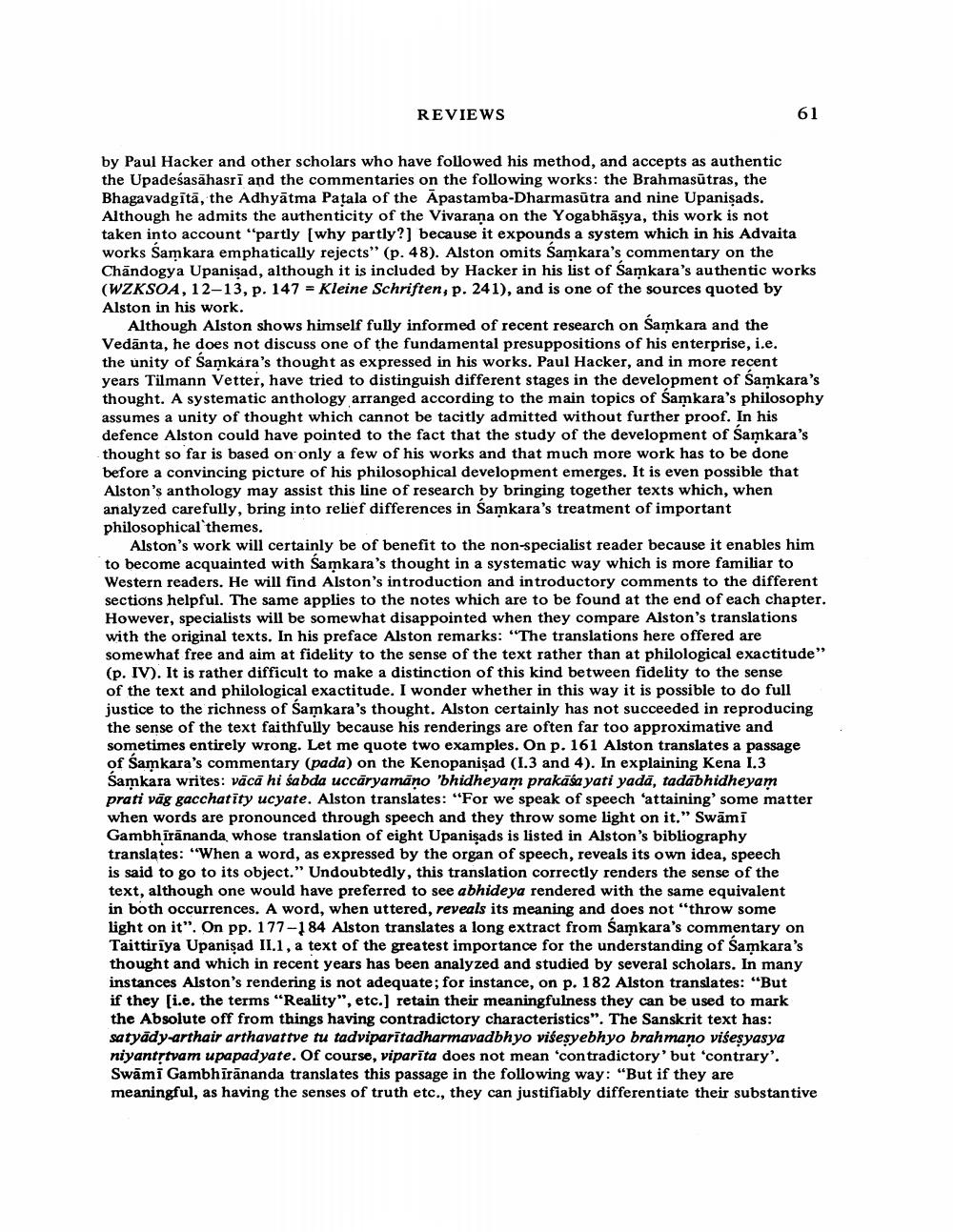Book Title: Book Reviews Author(s): J W De Jong Publisher: J W De Jong View full book textPage 3
________________ REVIEWS by Paul Hacker and other scholars who have followed his method, and accepts as authentic the Upadeśasāhasri and the commentaries on the following works: the Brahmasūtras, the Bhagavadgitā, the Adhyātma Patala of the Āpastamba-Dharmasūtra and nine Upanişads. Although he admits the authenticity of the Vivarana on the Yogabhāşya, this work is not taken into account "partly (why partly?] because it expounds a system which in his Advaita works Samkara emphatically rejects" (p. 48). Alston omits Samkara's commentary on the Chandogya Upanisad, although it is included by Hacker in his list of Samkara's authentic works (WZKSOA, 12-13, p. 147 = Kleine Schriften, p. 241), and is one of the sources quoted by Alston in his work. Although Alston shows himself fully informed of recent research on Samkara and the Vedānta, he does not discuss one of the fundamental presuppositions of his enterprise, i.e. the unity of Samkara's thought as expressed in his works. Paul Hacker, and in more recent years Tilmann Vetter, have tried to distinguish different stages in the development of Samkara's thought. A systematic anthology arranged according to the main topics of Samkara's philosophy assumes a unity of thought which cannot be tacitly admitted without further proof. In his defence Alston could have pointed to the fact that the study of the development of Samkara's thought so far is based on only a few of his works and that much more work has to be done before a convincing picture of his philosophical development emerges. It is even possible that Alston's anthology may assist this line of research by bringing together texts which, when analyzed carefully, bring into relief differences in Samkara's treatment of important philosophical themes. Alston's work will certainly be of benefit to the non-specialist reader because it enables him to become acquainted with Samkara's thought in a systematic way which is more familiar to Western readers. He will find Alston's introduction and introductory comments to the different sections helpful. The same applies to the notes which are to be found at the end of each chapter. However, specialists will be somewhat disappointed when they compare Alston's translations with the original texts. In his preface Alston remarks: "The translations here offered are somewhat free and aim at fidelity to the sense of the text rather than at philological exactitude" (p. IV). It is rather difficult to make a distinction of this kind between fidelity to the sense of the text and philological exactitude. I wonder whether in this way it is possible to do full justice to the richness of Samkara's thought. Alston certainly has not succeeded in reproducing the sense of the text faithfully because his renderings are often far too approximative and sometimes entirely wrong. Let me quote two examples. On p. 161 Alston translates a passage of Samkara's commentary (pada) on the Kenopanişad (1.3 and 4). In explaining Kena 1.3 Samkara writes: vācā hi sabda uccāryamano 'bhidheyam prakāśa yati yadā, tadabhidheyam prati vāg gacchatity ucyate. Alston translates: "For we speak of speech 'attaining' some matter when words are pronounced through speech and they throw some light on it." Swami Gambhīrānanda whose translation of eight Upanişads is listed in Alston's bibliography translates: "When a word, as expressed by the organ of speech, reveals its own idea, speech is said to go to its object." Undoubtedly, this translation correctly renders the sense of the text, although one would have preferred to see abhideya rendered with the same equivalent in both occurrences. A word, when uttered, reveals its meaning and does not "throw some light on it". On pp. 177-184 Alston translates a long extract from Samkara's commentary on Taittiriya Upanişad II.1, a text of the greatest importance for the understanding of Samkara's thought and which in recent years has been analyzed and studied by several scholars. In many instances Alston's rendering is not adequate; for instance, on p. 182 Alston translates: "But if they (i.e. the terms “Reality", etc.) retain their meaningfulness they can be used to mark the Absolute off from things having contradictory characteristics". The Sanskrit text has: satyädy-arthair arthavattve tu tadviparitadharmavadbhyo višesyebhyo brahmano višesyasya niyantstvam upapad yate. Of course, viparīta does not mean 'contradictory' but 'contrary'. Swāmi Gambhīrānanda translates this passage in the following way: “But if they are meaningful, as having the senses of truth etc., they can justifiably differentiate their substantivePage Navigation
1 2 3 4 5 6 7 8 9 10 11 12 13 14 15 16 17 18 19 20 21 22 23 24 25 26 27 28 29 30 31 32 ... 39
